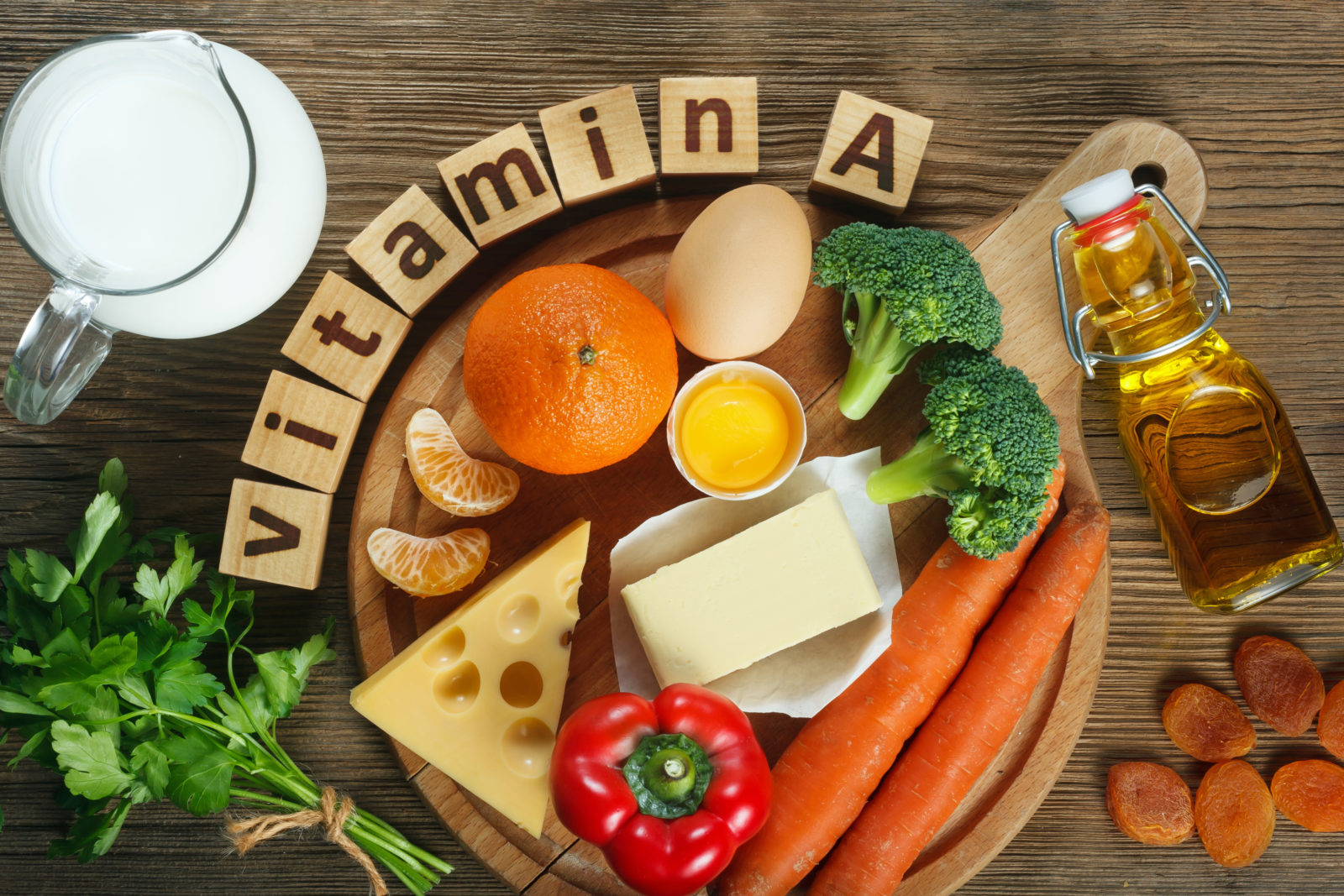What is Vitamin A?
Vitamin A is a fat-soluble compound, which means any amount not needed by the body is stored in either fat or the liver. Vitamin A is naturally found in food in two forms. The first form of vitamin A is retinol or preformed vitamin A, which is an active form of vitamin A commonly found in animal products, whole milk, fortified foods, animal liver. The second form of vitamin A is carotenoids which are found in plants. Fortified foods that typically have vitamin A are juices, milk, and cereals. Dietary supplements can sometimes be preferred to animal sources as animal sources are commonly high in saturated fats.
Vitamin A is important for normal and night vision, the immune system and reproductive health. Vitamin A helps maintain and form teeth, skeletal tissue and skin tissue. It also plays a fundamental role in cell division. Vitamin A has antioxidant properties. Excessive amounts of preformed vitamin A can increase the risk of bone loss, congenital birth defects, hip fractures, and potentially interfere in the beneficial actions of vitamin D, although this is not common in a typical diet. People who have kidney and liver disease or those who heavily drink alcohol should not take vitamin A supplements without consulting their physician. Vitamin A has been studied as a potential treatment for cataracts, HIV, and cancers.
In plantlife, vitamin A occurs as carotenoids, a plant secondary metabolite that is one of the most abundant pigments found in organisms. 600 carotenoids have been discovered, with 50 of them being categorized with characteristics of Provitamin A (such as alpha-carotene, beta-carotene, and beta-cryptoxanthin). It is most abundant in plant tissues that partake in photosynthesis (the green leaves of plants making them high in chlorophyll) and is in charge of the distinct colors of red, orange and yellow found on/in the skin of both plants – as well as the exoskeletons of certain fish such as salmon and carp as well as crustaceans such as lobster and shrimp – it is because these animals consume either plant matter or other animals that have themselves consumed plant matter high in carotenoids.
Health Benefits
- Promotes skin growth
- Promotes strong healthy hair
- Aids in preventing night blindness
- Improves vision
- Anti-oxidant & Immunity booster
- Essential for growth and healing
- Lowers risk of certain cancers
Dosage
1000-3000 IU depending on age. Up to 25000 IU can be taken for a short amount of time. 150000 IU only under the supervision of a medical doctor
Signs of Deficiency
- Inflammation and/or infection issues with eyes, ears, mouth, sinuses, lungs, or urinary tract
- Infertility; particularly in women
- Susceptibility to respiratory infections
- Increased risk of cancer
Risk of toxicity
Meat-based sources
- Beef liver, pan-fried
- Salmon, sockeye, cooked
- Lamb Liver
- Cod Liver Oil
- Goose Liver Pate
- Feta Cheese
Plant-based sources
- Carrots and Beets
- Sweet Potatoes
- Kale and cabbage
- Spinach and Rapini
- Broccoli
- Watercress
- Squash and pumpkin
Carotenoids have two main actions in plant cells; protection of the cell and accessory pigments – providing color. Some of these carotenoids can transform into retinol in the bodies of animals. There are around 50 distinct forms compounds of carotenoids that appear in plant life; beta-carotene being the most abundant. For a carotenoid to be of use to an animal body, it needs to be able to split into either retinol or retinoic acid.
Health Benefits
Promoting Skin and Mucosal Tissue Growth and Repair
Vitamin A stimulates the growth of the base layer of skin cells as well as membranes, which are the mucosal linings of the nose, the inner walls of the mouth, eyes, intestinal walls, lungs, and bladder. By strengthening the cells of these mucosal membrane linings vitamin A is also providing them with protection from the development of cancer.
Vitamin A aids in diminishing and preventing acne, as well as other inflammatory skin conditions such as psoriasis and ichthyosis.
Vitamin A aids in maintaining the structural integrity of mucosal membranes and ensuring their proper lubrication.
Promotes Strong Healthy Hair
Adequate amounts of vitamin A along with protein helps to promote healthy and strong hair. If you find that your hair is constantly breaking or is lacking that wonderful shine it may be a combination of a lack of beta-carotene and protein. What this particular vitamin provides the hair is beneficial nutrients for the scalp, aiding in the prevention of dandruff and itchy skin, making it exceptionally beneficial for individuals with psoriasis.
An Important Nutrient for Improving Vision
Vitamin A is also essential for the proper nerve function of the eyes – which also enables the ability of sight. It is needed to maintain the health of the cornea, which is the covering of the eye. A deficiency in vitamin A can lead to irritation and inflammation of the eye.
Apart from preventing night blindness, Vitamin A has also been shown to aid in the prevention or treatment of cataracts, glaucoma and age-related macular degeneration (Chaser-Taber, L., 1999)(Seddon JM, 1994).
Aids in Preventing Night Blindness
Night Blindness, which is also associated with diarrhea and respiratory problems is attributed to a deficiency in vitamin A. It was in the 19th century that an association was made between a decline in nutrition and night blindness on long naval sea voyages. Although vitamin A is fat-soluble it is often used up in the body if not replenished in about 6 months to a year.
Vitamin A is also associated with ‘visual purple’ which allows the eyes to adjust to light and dark environments. The pigment that vitamin A supplements in the body are Rhodopsin – and it is this pigment that is responsible for the adaptation.
Beta Carotene is a Potent Antioxidant & Immune Booster
Protects the body from free radicals, neutralizes them as well as aiding in combating oxidative stress which is attributed to infections and cancer.
The amount of vitamin A stored in the body is a direct correlation between the risk of cancer development.
If there is a drastic decline or lack of vitamin A in cells within the body there is an increased potential that such cells can become malignant
Retinol Essential for Growth and Healing
Vitamin A, especially retinol is crucial during the baby and fetal development and growth. vitamin a is essential in the body as it is required for the laying down of new cells and well as general homeostasis.
Retinol and retinoic acid are both needed for reproductive health and the development of embryonic (fundamental for the appropriate development of the nervous system, skin, lungs, eyes, ears, limbs, heart, lungs, and face) reproductive organ development.
Vitamin A is also essential for the proper formation and new bones and teeth as well as in the repair of damaged tissue.
Vitamin A Lowers the Risk of Certain Cancers
The Albert Einstein College of Medicine in New York had conducted studies under Dr. Wylie-Rosett looking at the correlation between women with abnormal PAP smear tests and low levels of Vitamin A intake. They saw that there was a greater likelihood that these women could develop cervical cancer or severe cervical dysplasia, which is a precancerous condition. Women who had an adequate daily intake of Vitamin A into there diet were found to have a lower risk of developing Cervical dysplasia or cervical cancer. In this study, they had primarily focused on the beta-carotene form of the nutrient, which is available in fresh brightly colors vegetables and fruits, such as carrots, broccoli, and kale. Researches in Milan had conducted a similar study on women, this time observing whether both forms of the vitamin from food sources would have the same impact on Vitamin A, although plant sources beta-carotene did show a definite reduction in the risk of developing cervical cancer, retinol from milk, liver, and meats did not provide the same benefit (Ed. Faelten, S., 1988).
The proof is in whole foods. It may not just be vitamin A but a combination of vitamins and minerals found in brightly colored vegetables. An 18 year Life Span study on the role of Fresh fruit and yellow-green vegetables in Hiroshima and Nagasaki, Japan found that there was a significantly reduced risk of cancer in individuals who lead a whole foods diet. Intake of fresh local fruit was shown to significantly reduced the risk of total cancer, particularly stomach cancer and lung cancer. A daily intake of green-yellow vegetables was shown to provide a marginally reduced risk of total cancer mortality as well as a significantly decreased risk of liver cancer mortality (Sauvaget, C., et al., 2003).

Food Sources
There are two different forms of vitamin A, retinoids which are found in animal sources and carotenoids which are found in plant sources. Although animal sources of nutrients are often far more easily absorbed in the body, diets higher in fresh vegetables have been shown to provide more benefits and are also able to reach the daily recommended dietary requirements for vitamin A.
It is important to understand that vitamin A is a plant secondary metabolite – carotenoid – and its abundance in plant life, and later in animal life – will decline if the plant does not receive proper nourishment from the soil as well as time for developing.
If an animal is not provided with its natural diet, as well as a stress-free happy environment it is likely that it will not naturally be high in vitamin A – not even in the liver. Intensive livestock operations may fortify their animal feed, however, a high-stress environment may cause the gut to not work as efficiently as it should, resulting in less vitamin A being brought into the body and what is stored would be quickly used up as an antioxidant to combat oxidative stress.
Choose both plant and animal sources wisely, think local and talk with your farmer!
Vitamin A foods including both plants and animals are listed below as well as the form of vitamin A either retinol or beta-carotene that is found within it.
Animal Sources – Retinol/Retinoic acid
Performed A is the animal source of vitamin A, also known as retinol. It is richest in the liver of pastured grass-fed animals and oily fishes. By being in retinol form already it doesn’t require much work from the liver to convert it into a form that the body can utilize. However, the consumption of processed animal products can provide more negative benefits to the body than beneficial ones. Below is a list of Animal Sources of Retinol;
| Food | Portion | Vitamin A (mcg) |
| Beef liver, pan-fried | 3 ounces | 6,528 |
| Salmon, sockeye, cooked | 3 ounces | 59 |
| Lamb Liver | 1 ounce | 2,122 |
| Cod Liver Oil | 1 tsp | 1,350 |
| Goose Liver Pate | 1 tbsp | 130 |
| Feta Cheese | 1 ounce | 35 |
| Chicken, breast meat and skin, roasted | 1/2 breast | 5 |
| Smoked Mackerel | 80g piece | 38 |
| Brie Cheese | 1 ounce | 49 |
| Blue Cheese | 1 ounce | 56 |
| Edam Cheese | 1 ounce | 69 |
| Gouda Cheese | 1 ounce | 47 |
| Unsalted Butter | 1 tbsp | 97 |
| Kefir | 80 mL | 83 |
| Egg, fresh, raw | large egg | 80 |
Plant Source – Beta-carotene
Pro-vitamin A is the plant source of the vitamin, also known as beta-carotene. It is found in bright and vibrant yellow and orange fruit as well as dark green leafy vegetables – the more intense the color the more nutrient-dense the produce. To obtain the most benefit from the fruit or vegetable it is best to eat local and in season, if the produce is coming from abroad considering organic is a good choice as it will be more nutrient-dense, even though it is picked earlier.
| Food | Portion | Vitamin A (I.U.) |
| Sweet Potato, baked | 1 | 24,877 |
| Carrot, raw | 1 | 20,253 |
| Carrots, cooked, sliced | 1/2 cup | 19,150 |
| Spinach, cooked | 1/2 cup | 7,370 |
| Squash, winter, butternut, cooked, cubed | 1/2 cup | 7,141 |
| Papaya | 1 | 6,122 |
| Kale, cooked, chopped | 1/2 cup | 4,810 |
| Cantaloupe | 1/4 | 4,304 |
| Turnip greens, cooed, chopped | 1/2 cup | 3,595 |
| Apricots | 3 | 2,769 |
| Brocolli, cooked | 1 spear | 2,537 |
| Watermelon | 1/16 | 1,762 |
| Tomato, raw | 1 | 1,530 |
| Avocado | 1 | 1,230 |
| Broccoli, cooked, chopped | 1/2 cup | 1,099 |
| Nectarine | 1 | 1,001 |
| Tangerine | 1 | 773 |
| Asparagus, cooked, sliced | 1/2 cup | 746 |
| Lettuce, loose-leaf, shredded | 1/2 cup | 532 |
| Peas, green, cooked | 1/2 cup | 478 |
| Peach | 1 | 465 |
| Okra, cooked, sliced | 1/2 cup | 460 |
| Lettuce, iceberg | 1/4 head | 445 |
| Beans, green cooked, sliced | 1/2 cup | 413 |

Deficiency Signs
Deficiencies may arise several reasons in the body and can be seen as these following symptoms and signs;
- Inflammation and/or infection issues with eyes, ears, mouth, sinuses, lungs, urinary tract.
- Infertility; particularly in women
- If one get colds or respiratory infections easily (especially children).
- Cancer.
If the intestinal tract is compromised and the enzymatic conversion of retinol in the intestines cannot occur absorption into intestinal cells will be an issue. An overgrowth of bacteria such as SIBO can also make it hard for absorption. If an individual is very low in cholesterol and chylomicrons cannot be formed properly the transportation of Vitamin A from the intestines to general circulation cannot successfully occur. This will inevitably compromise the utilization as well as the storage of Vitamin A by the liver and other cells in the body.
The liver stores between 50-80% of all the body’s retinol, if it is at full capacity it can hold enough stock to supply the body for between 6 to 9 months. However, if the liver is out of balance and working sluggishly, it will not only have trouble storing vitamin A but also be utilizing it.
Being constantly stressed or very sick can lead to a decrease in Vitamin A stores. However, apart from Vitamin A many other vitamins and minerals will be lost from the body, therefore, it is best to supplement with a potent multivitamin, as well as additional vitamin C, probiotics and herbals to strengthen the adrenals.
Supplementation and Recommended Intake
There are different ways to dosage Vitamin A and it is often dependant on the form of Vitamin A as well. It is common to see International Units (IU) listed on the supplement bottle or food labels. International Unites was the first measurement that Vitamin A went under, however, it does not provide a physical amount to how much vitamin A is truly present. IU expresses the level of chemical activity in the food or product. in the early 2000 micrograms of Retinol Equivalents (mcg REs) began being used, which provided an actual physical amount of the vitamin in question. There is a ration that will let you know the physical amount of Vitamin A if the Chemical activity is only listed: 1 mcg REs = 3.33 IU.
| Age | IU/Day | RE/Day |
| Infants | ||
| 0-6 months | 1,333 IU | 400 mcg RE |
| 7-12 months | 1,666 IU | 500 mcg RE |
| Children | ||
| 1-3 years old | 1,000 IU | 300 mcg Re |
| 4-8 years old | 1,333 IU | 400 mcg RE |
| 9-13 years old | 2,000 IU | 600 mcg RE |
| 14 and older | 3,000 IU | 900 mcg RE |
| Pregnant Women | 1,767 IU | 530 mcg RE |
| Lactating Women | ||
| 18 years old – younger | 2,933 IU | 880 mcg RE |
| 18 years oil – older | 3,000 IU | 900 mcg RE |
The supplemental dosage and maintenance dosage of Vitamin A should be around 5000IU/1500 mcg REs daily, although this is far less than the daily recommended amount, we do get a great deal of vitamin A in the foods we eat. Moreover, as vitamin A is fat-soluble it is not often that we are deficient in it (however, if you are under high stress or you get sick often, it is a vitamin that you should consider taking). If you are taking a multivitamin, make sure that it provides a good source and quantity of Vitamin A. Because toxicity is easy to derive especially with oral supplementation it is important to supplement for between 4 to 6 weeks and taking a break for a week or two – a supplement holiday!
25,000 IU daily can be taken for 1-2 months, no longer. You can cycle back to this amount of vitamin A after a period of time, which is dependant on your overall health. Higher dosages around 150,000 IU daily should only be done under the direction, guidance and possible supervision of a qualified healthcare practitioner. Vitamin A has been shown to possess virus and bacteria-fighting properties when taken at high doses. Elson M. Haas, MD., gives his patients a Vitamin A burst to supercharge their immune system and help them fight off infections, (this is done under physician supervision) beginning with 30,000 IU 3xdaily and working his way down over a week or two weeks. Though Vitamin A can be very beneficial for the body, when supplementing at home it is a lot safer to supplement and support the immune system with Vitamin C.
It is best to take a non-synthetic sourced Vitamin A (Performance or Provitamin), however, they can be hard to come by and even with fish liver oil the quality of the fish and it’s sourcing comes into question, especially when companies do not often disclose where they derive their ingredients from. I recommend Vitamin A supplements that do not contain soy, gluten, corn, sugar or dairy. These are common allergens and are products that are often genetically modified.
When taking the beta-carotene form of vitamin A, the toxicity is not as great (however individuals who have hypothyroidism and diabetes need to be careful) because the liver needs to convert the beta-carotene into retinol for it to be useful in the body. If the liver is not working to par this can be difficult.
Pregnancy and Supplementation
Women who are pregnant or plan on getting pregnant should not exceed 3000IU (supplemented) daily as high doses of Vitamin A can lead to a risk of birth defects in the developing child. As vitamin A is fat-soluble and is stored in the liver, it should not be exceeded during pregnancy.

Toxicity
As vitamin A is a fat-soluble vitamin and it is stored in the liver and not readily excreted, over-consumption of the nutrient (which is often done through extensive and excessive supplementation) can lead to toxicity. Preferred vitamin A, found in animal sources, can be toxic when consumed in excess through supplementation. Supplementation, apart from a multivitamin should not exceed one to two months.
Artificial sources of vitamin A, such as palmitate or acetate have a greater chance of toxicity in the body. The excessive dose is different for each individual; if one is ill, a smoker consumes alcohol to excess, has a poorly functioning liver, is suffering from chronic stress, exposure to environmental pollutants, etc., will require a possibly more substantial vitamin A requirement by the body.
A diet high in preferred vitamin A is very rare to result in toxicity, however, it can occur. Diets high in pro-vitamin A foods will not result in toxicity as the body self-regulate the conversion of the nutrient to its active form.
Symptoms and Signs of Toxicity
- headaches
- nausea
- vomiting
- dizziness
- abdominal pain/cramping
- hair loss
- itchy flaky skin
- bone abnormalities
- liver damage
References
Al Tanoury, Z., Piskunov, A., & Rochette-Egly, C. (2013). Vitamin A and retinoid signalling: genomic and nongenomic effects. Journal of lipid research, 54(7), 1761-75.
Eds. Blomhoff, R. (1994). A in Health and Disease. New York; Marcel Dekker Inc.
Borel, P., & Desmarchelier, C. (2017). Genetic Variations Associated with Vitamin A Status and Vitamin A Bioavailability. Nutrients, 9(3), 246.
Ed. Faelten, S. (1988). The Complete Book of Vitamins and Minerals for Health. Rodale Press; Pennsylvania.
Lisa Chasan-Taber, Walter C Willett, Johanna M Seddon, Meir J Stampfer, Bernard Rosner, Graham A Colditz, Frank E Speizer, Susan E Hankinson; A prospective study of carotenoid and vitamin A intakes and risk of cataract extraction in US women, The American Journal of Clinical Nutrition, Volume 70, Issue 4, 1 October 1999, Pages 509–516.
Eds. Litwack, G. (2007). Vitamin A. New York; Elsevier.
Ganguly, J. (1989). Biochemistry of Vitamin A. Florida; CRC Press Inc.
Haas, E.M., & Levin, B. (2006). Staying Healthy with Nutrition. Celestial Arts: New York.
Libien, J., Kupersmith, M. J., Blaner, W., McDermott, M. P., Gao, S., Liu, Y., Corbett, J., Wall, M., NORDIC Idiopathic Intracranial Hypertension Study Group (2016). Role of vitamin A metabolism in IIH: Results from the idiopathic intracranial hypertension treatment trial.Journal of the neurological sciences, 372, 78-84.
Metzler, M. A., & Sandell, L. L. (2016). Enzymatic Metabolism of Vitamin A in Developing Vertebrate Embryos. Nutrients, 8(12), 812.
Murray, M.T., & Pizzorno, J. (2012). The Encyclopedia of Natural Medicine. Atria Paperback; New York.
de Oliveira M. R. (2015). Vitamin A and Retinoids as Mitochondrial Toxicants. Oxidative medicine and cellular longevity, 2015, 140267.
Preedy, V.R. (2012). Vitamin A and Carotenoids: Chemistry, Analysis, Function and Effects. Cambridge; The Royal Society of Chemistry.
Sauvaget, C., Nagano, J., Hayashi, M., Spencer, E., Shimizu, Y., & Allen, N. (2003). Vegetables and fruit intake and cancer mortality in the Hiroshima/Nagasaki Life Span Study. British journal of cancer, 88(5), 689-94.
Seddon JM, Ajani UA, Sperduto RD, et al. Dietary Carotenoids, Vitamins A, C, and E, and Advanced Age-Related Macular Degeneration. JAMA. 1994;272(18):1413–1420.
Semba, R.D. (2012). The Vitamin A Story. Lifting the Shadow of Death. New York; Karger.
Tanumihardjo, S. A., Russell, R. M., Stephensen, C. B., Gannon, B. M., Craft, N. E., Haskell, M. J., Lietz, G., Schulze, K., … Raiten, D. J. (2016). Biomarkers of Nutrition for Development (BOND)-Vitamin A Review. The Journal of nutrition, 146(9), 1816S-48S.
Wiysonge, C. S., Ndze, V. N., Kongnyuy, E. J., & Shey, M. S. (2017). Vitamin A supplements for reducing mother-to-child HIV transmission. The Cochrane database of systematic reviews, 9(9), CD003648.
Amanda Filipowicz is a certified nutritional practitioner (CNP) with a bachelor in environmental studies (BES) from York University. She also has certification in clinical detoxification, prenatal and postnatal care as well as nutrition for mental health. She has been working as a nutritionist since 2013 and is a lifelong proponent of eating healthy.

